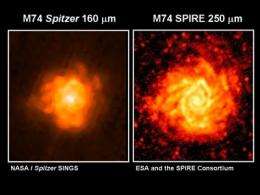Herschel first images promise bright future

Herschel has carried out the first test observations with all its instruments, with spectacular results. Galaxies, star-forming regions and dying stars comprised the telescope's first targets. The instruments provided spectacular data at their first attempt, finding water, carbon and revealing dozens of distant galaxies.
These observations show that Herschel's instruments are working beyond expectations. They promise a mission of rich discoveries for waiting astronomers.
SPIRE surprises with power
On 24 June, Herschel's Spectral and Photometric Imaging Receiver (SPIRE) was trained on two galaxies for its first look at the Universe. The galaxies showed up prominently, providing astronomers with their best images yet at these wavelengths, and revealing other more distant galaxies in the background of the images.
The pictures below show galaxies M66 and M74 at a wavelength of 250 microns, longer than any previous infrared space observatory, but still the shortest SPIRE wavelength.
SPIRE is designed to look at star formation in our own Galaxy and in nearby galaxies. It will also search for star-forming galaxies in the very distant Universe. Because these galaxies are so far away, their light has taken a very long time to reach us, so by detecting them we are looking into the past and learning how and when galaxies like our own were formed.
Herschel's primary mirror is 3.5 m in diameter, nearly four times larger than any previous infrared space telescope. These images prove that it represents a giant leap forward in our ability to study celestial objects at far infrared wavelengths.
The galaxy Messier 66 (M66) seen at two different wavelengths.
The galaxy Messier 74 (M74) seen at two different wavelengths.
Spitzer primarily observes shorter infrared wavelengths than Herschel, so the two telescopes complement each other.
The panel below shows SPIRE images of M74 at three different far infrared wavelengths.
These observations were all made on the first day that SPIRE was used. They clearly show that the main scientific studies planned with the instrument are going to work extremely well.
Water-hunter HIFI scores at first try
Scientists used Herschel's Heterodyne Instrument for the Far-Infrared (HIFI) on 22 June to look for warm molecular gas heated by newborn massive stars in the DR21 star-forming region in Cygnus.
HIFI provided excellent data in two different observing modes, returning information on the composition of the region with unprecedented accuracy and resolution. It works by 'zooming in' on specific wavelengths, revealing different spectral 'lines' that represent the fingerprints of atoms and molecules and even the physical conditions of the object observed. This makes it a powerful tool to study the role of gas and dust in the formation of stars and planets and the evolution of galaxies.
Using HIFI, scientists observed ionised carbon, carbon monoxide, and water in DR21. These different molecular lines add their pieces to a more complete understanding of what is happening.
The high quality of these first observations promises great new insights into the process of star formation.
PACS stares into the Cat's Eye
The first observation with the Photodetector Array Camera and Spectrometer (PACS) instrument was carried out on 23 June.
The first target was the dying star known as the Cat's Eye Nebula. Discovered by William Herschel in 1786, this nebula consists of a complex shell of gas thrown off by a dying star. Dying stars create spectacular nebulae, enriching the interstellar medium with heavy chemical elements. But how does an initially spherical star produce such a complex nebula? To solve this question we need to look at the processes close to the star, where the matter is ejected.
With the PACS spectrometer it is now possible for the first time to make images in spectral lines for on the sky, and see how the wind from the star shapes the nebula in three dimensions. The PACS spectrometer was used to look into the Cat's eye. This mode records the composition and condition of celestial objects at precisely defined wavelengths.
PACS observed the nebula in two spectral lines from ionised nitrogen and oxygen. For better orientation, the PACS photometer took a small map of the Cat's Eye Nebula in its 70 micron band, showing the structure of a dust ring with an opening on one side.
Following these first light images, Herschel is now in the performance verification phase, where the instruments will be further tested and calibrated. This phase will last until the end of November, after which the mission will begin its routine science phase. These images show that there is a lot of science to look forward to.
Source: European Space Agency (news : web)



















